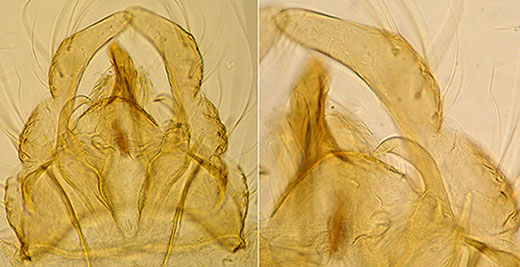C. n.sp.? Queensland
A single reared male from Green Swamp, Qld., differs from other known Australian species. Adult male:
A medium sized species. Possibly fairly pale.
Wing length 3.14 mm, width 0.78 mm. Wings unmarked other than a slight darkeneing of the cross-vein. VR 0.96; 2-3 Scf on brachiolum, setae on margin of squamal fringe not seen.
Head: AR about 3.18. Frontal tubercles small, 25 µm long and 2.9-3.3 times longer than wide. Palpal proportions (micron) 51 : 53 : 168 : 200 : 311 ; P5/P4 1.55, P5/P3 1.85. Clypeus about 0.66 of diameter of antennal pedicel, with 17 setae.
Thoracic setae - at least 10 Acrostichals, 15-16 Dorsocentrals, 6 Prealars, 1 Supraalar and about 2 small and posterior row of 13 larger setae (total 15) on Scutellum.
Legs pale, lengths (micron) and proportions:
| Fe
| Ti
| Ta1
| Ta2
| Ta3
| Ta4
| Ta5
| LR
| F/T
| Ta5/Ti
| PI
| 1140
| 960
| 1595
| 785
| 710
| 620
| 305
| 1.66
| 1.18
| 0.32
| PII
| 1215
| 1115
| 660
| 355
| 245
| 155
| 135
| 0.59
| 1.09
| -
| PIII
| 1415
| 1365
| 1035
| 555
| 430
| 270
| 160
| 0.76
| 1.04
| -
| BR about 1.4
Abdomen with a, probably light brown, diamond shape on tergites II-V, then along midline of the segments. 16 setae in a single long, roughly triangular, pale area of TIX. Superior volsella closest to E(h)-type of Strenzke (1959); anal point narrower at base. Inferior volsella to middle of anal point or about 1/3 up the moderately swollen gonostylus, with recurved setae apparently simple. Gonostylus narrows only slightly over posterior half, with 8 setae at the tip. Pupa: Exuvial length about 7 mm; inner margin of wing case about 1.52 mm. Cephalic tubercles about 35 x 25 µm (1.4 times longer than wide), posterior to a small pair of frontal warts about 18 x 35 µm (0.5 times as long as wide).
Respiratory base 152 µm long and 67 µm wide, respiratory fibres narrowing in middle, HR 2.24-2.35. There is a single depressed area just anterior to each respiratory base.
About 62 recurved spines on second segment, occupying about 75% of the segment width. Pedes spurii B only determined for segment II; pedes spurii A on segment IV about 172 µm long, 90 µm wide and about 0.25 of the segment length. L-setae at III/IV margin at least 43 µm long and at IV/V margin at least 68 µm long.
Spurs of segment VIII dark yellow brown, with 1 main spine plus a small spine on each side on one spur (below); about 67 taeniae on each side of anal lobe, in a double row at posterior end. Fourth instar larva: The larval head capsule was attached to the pupal exuvia. Larval type is not known but the following characters could be determined:
Ventral Head Length about 276 µm; gular v.slightly darkened on posterior third, no indication of any darkening of the Frontoclypeus. Oesophageal opening about 58 µm wide and 5.75 times wider than deep.
Mentum (Fig. d) width 157 µm, 0.57 of VHL; mentum type I-ii (i.e. 4th laterals slightly reduced) and central trifid tooth of type III.
Ventromentum (Fig. e) about 167 µm wide, 3.6 times wider than deep and 1.06 times the mentum width; about 43-44 closely spaced striae; IPD about 0.34 of mentum width; VMR 0.16. Pecten epipharyngis (Fig. a) with 15 long sharp (type A) teeth.
Premandible (Fig. b) with relatively broad teeth (type D) which come to a relatively broad point; inner tooth about 4 times wider than the outer tooth.
Only the basal antennal segment remained (Fig. c); relatively long (0.43 of VHL, and 4.1 times longer than wide) with the RO about 0.39 of segment length up from the base of the segment. Relationship of the distance between the antennal bases and that between the S4 setae could not be determined; S5 setae about level with the nearby RO.
Mandible (Fig. f) about 182 µm long, of type IIB; with about 16-17 furrows on outer surface at base; Pecten mandibularis about 12-13 taeniae; Mdt_Mat about 23, MTR 0.33. Found in a pool along with C. tepperi. Found:Queensland - Green Swamp (-28.00°S; 148.8°E) about 40 Km south of Roma. [ Return to Index | Go to References ] |
